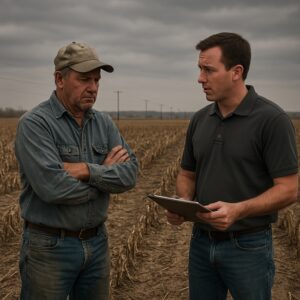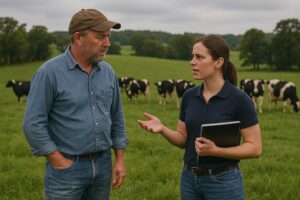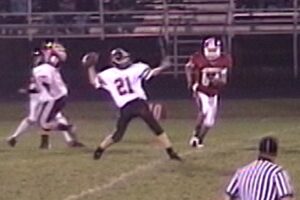Sales Territory Organization
While it doesn’t sound like a very exciting or important topic, trust me that it is extremely important in being able to grow your territory beyond your dreams. Does this describe you or one of your Ag sales reps? A truck full of promo gear to hand out, feed or grain contracts signed & unsigned scattered amongst the inside of the pickup truck, a cup of coffee and a spit can in the drink holder, 20 minutes late for your next appointment, GPS is screaming at you to do a U-turn and your voicemail box is full. Oh, and that email that reminded you to get on the company conference call to learn how to sell a new product was lost in the chaos of the morning. Maybe a bit dramatic, but then again I’ve seen several sales people’s trucks look pretty close to it. Throw in a couple car seats and some half-full baby bottles in there for the ones that have kids.
In my earlier blogs, I emphasized the importance of segmenting your customers and how you can easily increase your productivity 50% by calling on the right customers.
A close second in importance is Sales Territory Organization. I call it Sales Territory Organization because it’s slightly different and more to it than just organizing your desk & files as someone in an office might do. Prior to starting my feed sales career, I prided myself on having a clean desk in my office as a regional feed business manager. I touched a document once and handled it. I responded quickly to those AS400 “Wire/teletype” messages and didn’t delay in getting my paperwork sorted into files. Then I launched into the world of feed sales…calling on livestock producers, ag retailers and distributors. The seasonality of the animal production industry as well as trade shows that snuck up and buried me from week to week. I was making a lot of cold calls and dropping the ball as I couldn’t keep it all straight at the end of the day. With a relatively large territory (parts of three states), I would get home late from making farm calls and either not have the energy or desire to log the information into a format that I could use or recall for follow up. I was out of control and knew it wasn’t going to get better when I had more customers to work with. After building a territory, a certain amount of time is needed just to maintain those customers. So, I knew I had to get organized, right away.
The five categories that I grouped my organizational skills into were:
Customers, Technology, Work Supplies/Equipment, Seasonality and Geography.
- Customers – As mentioned, I can’t emphasize enough, the need to segment your customers. This gets you to call on the right customers and saves you the time from calling on the wrong ones. See earlier blogs. However, there’s one more step in that process. Ask yourself on each customer, “How often do I need to go see them?” Please don’t ask, “How often do they want to see me?” I have seen many sales people who make routine sales calls because that’s what they’ve been doing for years – “I always have a Tuesday appointment with Smith Farms” If you are getting good work done, the customer is valuing it and it is core to keeping the customer, then great. Keep up the good work. However, if it has turned into an ongoing social event where you aren’t really transacting business, I would highly consider changing the frequency of those type meetings. Go down your customer list and next to each customer write how often you need to be there…weekly, monthly, never. Keep that list handy for the next step
- Technology – It’s here, it’s helpful and you just need to jump in and embrace it. To be organized with it means to
- Train with it before you get in front of a customer. It’s unprofessional to get on the farm, break out the program and announce that you don’t know how to use it. It wastes the customer’s time to fumble around learning the program on their time.
- Web site – scour your web site as well as the customers and allied businesses. At a minimum, know your own site front to back. Understand the difference between your view as an employee versus what the customer sees. Click on every button and know how to use them. You never know what a customer might find valuable.
- E-mail – This should really be a whole blog unto itself. You could describe work history as BE (Before email) or AE. Once we figured out PDL’s, we decided we should copy the whole world on every e-mail. It consumes you if not handled correctly. Many advise us to pick a certain time of day to do email and don’t check it constantly throughout the day. Good advice, but I still find the addiction to “Seeing what’s happening” when I’m making sales calls and have a break. Use blocking to send junk to a junk folder. Delete quickly so your In-Box remains uncluttered. Use an “Active” or “Look at” folder to throw semi urgent e-mails into that you need to follow up on. Know who’s emails you need to read and reply to. The top two that come to mind are customers and your supervisor. The other qualifier that I use is if it was sent just to me or to a large PDL. Just to me e-mails get a few more seconds of review before handling them. Use folders in Outlook so you can quickly organize them out of your In-Box. It also helps you later on when you try to retrieve the email. Learn how to quickly search folders in Outlook for a key word, like a person’s name that sent you the e-mail. It’s very simple to do.
- CRM – The dreaded Customer Relationship Management program. Demonized as a time wasting Facebook for business. Heralded as the greatest solution to everything you need to organize a company around a customer. After launching them three different times with three different sales teams, I can tell you that a CRM tool can be both of the two descriptions above based on how you use it. It’s a software program. So, GIGO is in effect. Garbage in Garbage out. I’ve heard the complaint “I don’t have time to sit down at 8 p.m. and log in every time I have a Diet Coke with a customer” My reply is, “Well, if that’s what you thought you should write in a customer entry log, then we probably need to have a different discussion” Get the priorities in there…price quotes, contract quotes, follow up items, any agreed upon actions and certainly time lines for any actions. If you have complicated products (futures & options strategies) log in how you explained the program. These notes will be invaluable when the time comes to execute on those contracts. Livestock death loss or feed complaint notes are much easier to pull up on a CRM tool than digging around in your notebooks.
CRM started out as a notebook in your top pocket, moved onto maybe a graph paper chart, graduated to an Excel spreadsheet and now is going through an evolution of CRM software products. They are extremely helpful if used correctly. However, if still not convinced on CRM, then at a bare minimum, you can construct a quick spreadsheet on Excel to organize your customer info. Customer name, date of last contact, date to Follow Up and Follow up activity. For example:
| Customer | Last Contact | Next Contact | F/U Needed |
| Smith Farms | 7/10/2016 | 9/20/2016 | Min Prx contract |
| Jones Farms | 9/22/2016 | 9/23/2016 | Calf creep program |
| Countyline Feed | 9/16/2016 | 9/23/2016 | Sweet feed promo |
| Triple A show steers | 9/19/2016 | 9/26/2016 | fat supplement info |
You can easily sort from oldest to newest on either date column. You can add a column with contact info so it’s easy to make calls while safely parked along the road somewhere. Most CRM tools will do all of this and even more for you, but if you either don’t have one or are allowed to not use the one that your company pays good money each month to have J, then maybe use this simple Excel format.
Part 2 – Next we’ll deal with those aspects that make Ag sales a bigger challenge in some ways… Work Supplies/Equipment, Seasonality and Geography
Until then, sort your customers and challenge yourself on how often you need to go see each customer. Start organizing your In-Box and Outlook folders so you don’t waste time searching constantly or losing e-mails.
To Schedule a Free initial coaching session today, contact me directly at Greg@GregMartinelli.net
For more on Ag Sales Training, Ag Sales Coaching and Leading Ag Sales Teams, go to
http://www.GregMartinelli.net/



